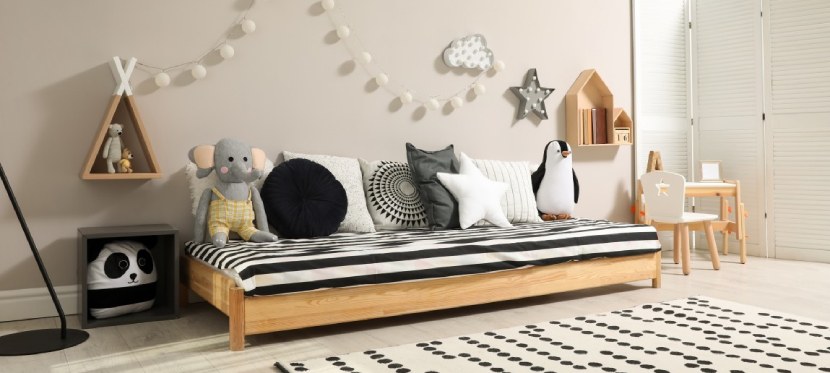As parents, we are constantly seeking the best ways to foster our children’s development, and one approach that has gained widespread recognition is the Montessori method.
Тhis educational philosophy encourages independence, self-directed learning, and a deep sense of respect for children’s natural curiosity. One of the key places where the Montessori principles can be applied is your child’s bedroom.
In this article, we will guide you through the process of creating a Montessori-inspired kid’s bedroom, where your child can thrive, learn, and grow in a space that values their individuality and autonomy.
The Montessori Philosophy: A Brief Overview
Before diving into the design details of a Montessori-inspired kid’s bedroom, it’s crucial to delve deeper into the core principles of the Montessori philosophy.
These principles not only lay the foundation for the design but also shape the entire educational approach that underpins this unique approach to child development.
- Independence: Montessori philosophy places a strong emphasis on fostering independence in children. In a Montessori-inspired bedroom, this principle translates into creating an environment that supports a child’s ability to make choices and take initiative. Child-sized furniture and accessible materials empower them to dress themselves, choose activities, and even tidy up their space. This early encouragement of independence sets a solid foundation for a child’s lifelong confidence and self-assuredness.
- Hands-On Learning: Central to Montessori education is the belief that children learn best through hands-on experiences. Learning is not confined to textbooks and lectures; it’s a dynamic, interactive process. In the context of a bedroom, this principle means providing children with materials and activities that engage their senses and encourage exploration. These materials often have a sensory aspect, such as textured objects or materials in various colors and shapes. By engaging in these activities, children develop cognitive, motor, and sensory skills organically, without the need for external pressure.
- Order and Routine: Montessori environments are known for their sense of order and structure. Maintaining order within a child’s surroundings is not merely about aesthetics; it provides children with a profound sense of security and stability. Predictable routines, such as having designated places for toys, clothing, and other items, help children feel in control of their environment. Knowing where to find their belongings and what to expect each day reduces anxiety and promotes a sense of confidence.
- Respect for the Child: At the heart of the Montessori philosophy is a profound respect for the child as an individual with unique interests and capabilities. This principle informs every aspect of Montessori education, including the design of their physical spaces. In a Montessori-inspired bedroom, adults play a supportive role in the child’s development, rather than imposing their preferences or limitations. By respecting a child’s choices, interests, and pace of learning, adults foster a sense of autonomy and self-worth.
Creating a Montessori-Inspired Kid’s Bedroom
The foundation of a Montessori-inspired bedroom begins with the furniture. Opt for child-sized furniture that empowers your child to independently access their belongings. A low, sturdy bed allows them to get in and out safely.
Consider open shelving or cubbies for storing clothes, toys, and books within easy reach. Having their belongings at their level fosters independence and a sense of ownership.
Simplify the Space
A clutter-free environment is essential in Montessori philosophy. Keep the bedroom simple, with only a few carefully chosen toys and activities available at a time.
Rotate toys regularly to maintain interest and prevent overwhelm. Ensure that each item has a designated place on the shelves to encourage tidiness.
Promote Independence
In a Montessori-inspired bedroom, everything should be within your child’s reach. Hang hooks at child height for clothes, so they can select and put away their clothing independently.
Place a small step stool nearby to help them reach higher items. A low, child-friendly mirror allows them to see themselves and practice self-care skills.
Natural Materials and Sensory Experiences
Choose furniture and materials made from natural, non-toxic materials such as wood and cotton. Avoid plastic whenever possible.
Incorporate sensory-rich elements like soft rugs, textured fabrics, and soothing colors. Natural light and plants can also enhance the sensory experience of the room.
A Place for Learning
Include a cozy reading nook with a soft chair or floor cushion and a selection of age-appropriate books. A low table or workspace can be used for art and other creative activities.
Keep supplies like crayons, paper, and craft materials easily accessible for spontaneous exploration and creativity.
Order and Routine
Maintain order in the room by labeling shelves and bins with pictures or words to help your child identify where items belong.
Establish a daily routine for activities such as dressing, reading, and tidying up. Children thrive on predictability, and routines provide a sense of security.
Encourage Exploration and Independence
To encourage exploration and independence, provide opportunities for your child to make choices. Offer a few clothing options each day and let them decide what to wear.
Rotate toys and materials to spark their curiosity. As they grow, involve them in decorating and organizing their space to foster a sense of ownership.
A Calm and Cozy Sleeping Environment
A comfortable and inviting sleeping area is crucial for restful nights. Use soft bedding and a mattress that provides proper support. Create a bedtime routine that includes calming activities like reading or soft music. Avoid screens in the bedroom to promote healthy sleep habits.
Designing a Montessori-inspired kid’s bedroom is not just about aesthetics; it’s about creating a nurturing environment that supports your child’s growth and development.
By embracing the principles of independence, hands-on learning, order, and respect, you can provide a space where your child can thrive, learn, and become more self-reliant.
As you embark on this journey, remember that every child is unique, and their bedroom should reflect their individual needs and interests.
With love, patience, and a child-centered approach, you can create a Montessori-inspired haven where your child can flourish.





